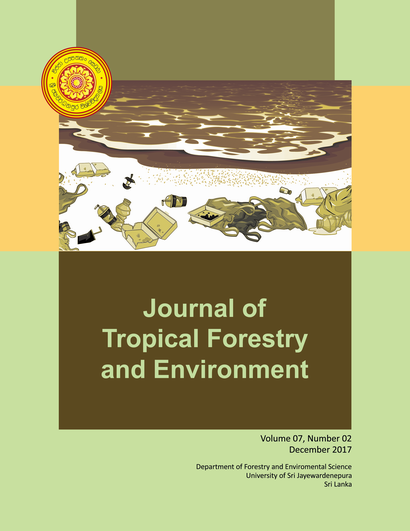Pathological characterization of Corynespora cassiicola isolates from traditional and non-traditional rubber growing areas
DOI:
https://doi.org/10.31357/jtfe.v7i2.3312Abstract
Rubber (Heveabrasiliensis) is one of the major economically important estate crops and generates the third largest export income of Sri Lanka. Rubber plantations established mostly in Wet Zone and certain regions in Intermediate Zone and the cultivated areas are known as traditional areas. However, presently rubber cultivation has been expanded to the dry zone of country and the cultivated areas are known as non-traditional areas. Corynesporacassiicola is the most destructive foliar pathogen of the rubber plant causing Corynespora leaf fall disease (CLFD) and the disease has caused a major devastation in rubber industry resulting in a remarkable economic loss. This study aimed to determine the variability of C. cassiicola isolates from traditional and non-traditional rubber growing areas using pathological factors. Ten isolates of C. cassiicola which had been isolated from diseased leaves of different clones grown in traditional (five isolates) and non-traditional (five isolates) areas were used for characterization. Variability in pathogenicity, temperature sensitivity, growth rate, conidia production, fungicide sensitivity to two fungicides; mancozeb and carbendazim and toxin production were examined. Data were statistically analyzed and the final analytical output revealed a statistically significant difference (p <0.05) between the isolates, but not between two geographical regions for all parameterstested except for toxin production and sensitivity to carbendazim. Though isolates of C.cassiicola show significant difference in pathological factors among isolates irrespective of geographical location, they do not behave differently in different climatic regions.
Keywords: Corynesporacassiicola, CLFD, toxins, traditional and non-traditional areas
Downloads
Published
How to Cite
Issue
Section
License
The publisher retain the copyrights of contents published, and all open access articles are distributed under the terms of the Creative Commons Attribution-Noncommercial-No Derivative Works 3.0 Unported License[U1], which permits unrestricted use, distribution and reproduction in any medium, provided that the original work is properly cited.
You can download the Legal Code for this License at: http://creativecommons.org/licenses/by-nc-nd/3.0/legalcode


